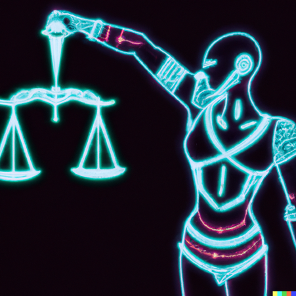
The rapid advancement of artificial intelligence (AI) has ushered in a new era of innovation and creativity surpassing human capabilities. AI now not only replicates human abilities in crafting poetry, composing music, and generating intricate artworks but also extends beyond them, erasing the line between human and machine creativity. As its name suggests, AI aims to make computers and software think like the human mind by studying patterns in the human brain and analyzing cognitive processes. Recently, image generators such as Stable Diffusion, Midjourney, or DALLE-E 2 are capable of producing all types of works using thousands of images in a database.[i]
Amid this technological evolution, one area of the law that has become significantly impacted is intellectual property law, and copyright law as a whole. AI-generated works have raised numerous complex questions, primarily whether AI technology infringes upon existing copyrighted materials. This issue arises due to the process behind training AI models. Recent Technology now enables AI to create art in a dynamic interaction with users. Individuals can input specific word prompts, guiding AI systems to produce unique, tailored pieces of art. To do this the AI must go through machine learning, which involves processing an incredible amount of input training data to identify patterns.[ii] As such, the more training data, the more precise and valuable output data. Often, these massive datasets contain copyrighted materials—photos, paintings, books, or even computer source code.
Copyright law protects the rights of creators, granting them exclusive control over how their work is used and the ability to benefit financially from it.[iii] However, given the absence of clear legal guidelines, AI-generated works pose a threat to artists’ rights to control and profit from their creations. For example, OpenAI, a prominent AI research organization, has acknowledged using vast datasetsto train its AI models, including copyrighted works. As a result, the creation and utilization of copies of these works without explicit or implicit permission from the copyright owners may infringe upon their exclusive rights.
Currently, the methods employed by AI in utilizing copyrighted materials during the art generation process have raised serious concerns regarding infringements of copyright law. These concerns are beginning to be acknowledged, and efforts to address and mitigate such issues are emerging. However, recent developments indicate that answers may be on the horizon. Getty Images, an image licensing service, has recently filed suit against Stability AI, the company behind Stable Diffusion, for copying and processing millions of images that are protected by copyright without obtaining their permission or even providing compensation. Additionally, in Andersen v. Stability AI et al., Sarah Anderson, Kelly McKernan and Karla Ortiz have filed a class-action copyright infringement lawsuit against both Stability AI and Midjourney, which use Stable Diffusion to generate images.[iv] The suit claims that their work was wrongfully used to train Stable Diffusion, and that the images generated in the style of those authors directly compete with their own works.
In each of these cases, courts are asked to provide guidance on the bounds of what constitutes a “derivative work.” The outcome of these cases would hinge on the interpretation of the Fair Use Doctrine, which allows copyrighted works to be used without the owner’s permission for alternative purposes. Such purposes include criticisms, comment, news reporting, teaching, research, or transformative use of the copyrighted material in a manner for which it was not originally created.
The answer for AI systems to move away from copyright infringement may lie in the transformative use factor of Fair Use. Transformative use occurs if its result and the original copyrighted work serve different market functions.[v] Further, A transformative use offers something new and different from the original or expands its utility, thereby serving the copyright’s overall objective of contributing to public knowledge.[vi]
Intellectual property laws are designed to foster and safeguard artistic and scientific progress, ensuring creators receive recognition and compensation for their contributions.[vii] As such, the rise of AI presents a novel challenge that demands careful consideration. To navigate this evolving landscape, it is crucial for the courts to promptly address AI technology and establish guidelines that align with intellectual property principles. Striking a balance between promoting technological progress and safeguarding artists’ and creators’ rights is a delicate task. Courts must weigh the interests of AI developers, who drive innovation, and artists, who deserve protection for their original works.
In conclusion, the rise of AI technology has transformed various aspects of daily life, including the complex realm of intellectual property law. As AI-generated content continues to grow, the legal system faces a novel challenge of adapting to this new frontier. The outcomes of ongoing lawsuits and changes to copyright law will shape the landscape for AI and intellectual property, ultimately defining the path forward for innovation, creativity, and the future of artistic expression in the digital age.
[i] See Gil Appel, et al., Generative AI Has an Intellectual Property Problem, Harv. Bus. Rev. (Apr. 7, 2023). https://hbr.org/2023/04/generative-ai-has-an-intellectual-property-problem.
[ii] See Diana Bikbaeva, AI Trained on Copyrighted Works: When Is it Fair Use?, TFL (Feb. 1, 2023),
https://www.thefashionlaw.com/ai-trained-on-copyrighted-works-when-is-it-fair-use/.
[iii] See generally What is Copyright?, COPYRIGHT.GOV, https://www.copyright.gov/what-is-copyright/ (last visited Sep. 27, 2023). see also 17 U.S. Code § 106.
[iv] See generally James Rosenfeld, et al., I Cant Get No Compensation: AI mage Generators and Copyright, DAVIS WRIGHT TREMAINE LLP (Feb. 15, 2023) https://www.dwt.com/insights/2023/02/ai-copyright-andersen-stability.
[v] Campbell v. Acuff-Rose Music, Inc. 510 US 569, 591 (1994).
[vi] Authors Guild v. Google, Inc. – 804 F.3d 202, 214 (2d Cir. 2015).
[vii] See generally Harper & Row v. Nation Enterprises, 471 U.S. 539 (1985) (putting forth the principle that a right to the use of one’s own expression supplies “economic incentive to create and disseminate ideas.”).



